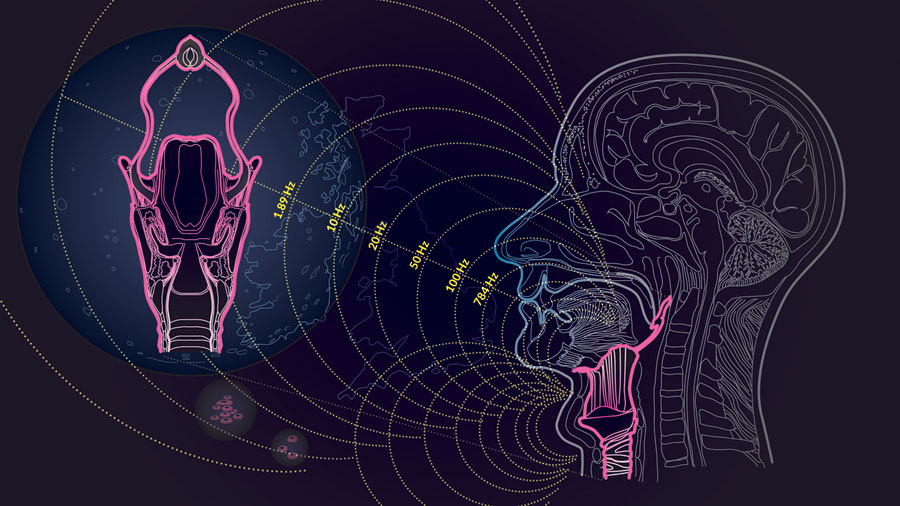Can a singer help bridge a divided nation?
2 May 2019

BurtonNitta’s ‘New Organs of Creation’ receives its world premiere on the 8 May 2019 at the Science Gallery, London. Read on to understand what their approach means for the evolution of song and performance practice.
Song unites. When the opening chords of Parry/Blake’s Jerusalem resound, some people sing about “mountains green” and “dark Satanic mills” with misty eyes of national pride. Or consider Puccini’s aria, Nessun Dorma, where football and opera unite as one under the dulcet and triumphant tones of Pavarotti. Then there’s the Beatles, Hey Jude, where thousands of strangers in an arena offer friendship by singing these words with heartfelt gusto: “Nah, nah, nah, nah, nah, nah, nah.”
Music transcends barriers. It brings people together, touches hearts and lifts us to a different place. In these moments, some get goose bumps, others feel the hairs on the back of their neck stand on end, some time travel back to the moment they first heard the song.
With songs profound ability to change our physiology and emotional state at an individual and crowd level, BurtonNitta step into the future in their latest interdisciplinary project, New Organs of Creation, to explore song’s potential to connect and influence at a heightened level.
About New Organs of Creation
In New Organs of Creation, BurtonNitta consider a future Britain, divided by the ravages of post-Brexit. They ask, can song help us find the way to understanding and save our troubled nation? To approach this question, BurtonNitta are specifically exploring the vocal form of an anthem to see if it can create a bridge to understanding.
In my introduction, I observed the power of a song’s sound to shift our state. At a deeper level, scientific research builds on this and evidences that sound can help direct matter. For example, low sound frequencies (50HZ – 100HZ) can nurture stem cells into bone cells. If we also consider mindfulness practices, where sound has been used to heal and enable the transformation of consciousness for centuries, a bigger picture of frequency and vibration emerges.
To explore the directional potential of frequency and vibration, BurtonNitta have put together an interdisciplinary team crossing science, art, performance, music and technology. The purpose of our collaboration is to create an experience that changes the state of our physical world by immersing the audience in an anthem that speaks directly to our body at a cellular level.
BurtonNitta Approach
To help achieve this profound state change, capable of building a bridge towards understanding, a hypothetical human larynx has been created between BurtonNitta and Prof Lucy Di-Silvo (Kings College) using tissue engineering and the scaffold of the larynx 3D printed with Dr Trevor Coward (Kings College). The structure of the larynx takes inspiration from other animals, such as the koala and the cat, to extend the ability of the human voice as a transformational instrument.
With a voice that has been enabled to reach these lower frequencies, a new anthem has been created to go beyond divisions. Matt Rogers (composer), David Sheppard (sound designer) and myself, Louise Ashcroft (mezzo soprano), will take the audience on a journey as we share our music at a cellular level:
“With this voice, the singer performs an anthem expressing a national identity for the future of what many are calling “Britain’s divided nation”. BurtonNitta
The role of the singer
As we explore the potential of this new national anthem, the modern-day purpose of song and the role of a singer is shifting.
In today’s society, song is performative. Singers are megastars in the opera house and the arena. However, this performative aspect of the singer’s role no longer fits the new paradigm of New Organs of Creation. Rather, there is return to the original form of song when it was transformative. Where singing nurtured communities enabling them to survive, communicate, heal and grow.
This return to a transformative function means that the role and performance practice of the modern-day singer seismically shifts. In New Organs of Creation, to serve the community, the singer must tune into the people’s needs, hopes and fears. This means that the music of the anthem isn’t created by following a score, but by tuning into the community’s emotional landscape to enable the transformation of consciousness through structured improvisation. Furthermore, as the singer tunes into the community, they might find themselves being at once an interpreter, diplomat, leader, healer.
This sense of singing for a greater good has brought about shifts in my personal vocal approach. Let’s look at my starting point: I’m a trained classical singer. In my world, and also the popular music world, loud high notes and lots of fast-moving notes (melisma or colatura) have been coded as mastery. However, in the New Organs of Creation paradigm, this vocal mastery is obsolete. Rather, mastery comes in the form of profound listening to enable transformation. The use of breath – both the inhale and exhale – creates an ostinato on top of which the love and angst of a nation’s divide are heard and understood in shifting harmonics and enharmonics as singer and sound designer duet.
As the singer’s role shifts to connect to the purpose of singing for a higher good, new skills are required. In this instance, a multi-level perspective – much like that of a coach – needs to be achieved. To enable dynamic change the singer needs to sponsor others in order to resolve a complicated problem. So, in BurtonNitta’s new paradigm, singing is no longer about making that top C or that super long phrase. Rather, it’s about singing for the good of a nation.
——————
New Organs of Creation, world premiere on 8 May 2019 at the Science Gallery, London.
Artwork for the blog post header – BurtonNitta, New Organs of Creation, 2019.
To find out more about the performance piece, click here
To book your free ticket, click here
